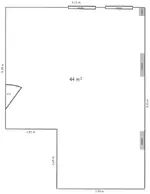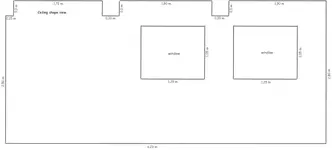J
JahooRoisym
New member
Hi everyone,
I recently got access to a new rehersal room (gig room, or how do you call it?) in a nice and tall basement. It is in a rather raw state, and there is a lot of work ahead of me and my band members.
I have two questions for people who know their stuff in acoustics:
1. What best to put on the floor? Right now we have raw concrete (cement) on the floor. I am thinking floor-covering or carpenting or perhaps linoleum (PVC) and carpets on top of that. What would you advise? We are semi-tight on budget, but I think I would rather invest more in the ceiling and wall acoustic pannels, bass traps.
2. There is a rather curious ceiling shape (see the second picture below). I'm considering to build a drywall suspeneded ceiling, fill the void over it with insulation fiber and than put acoustic foam panels - like the ones here
rjelectronics.org/wp-content/uploads/2011/07/004_foam_pieces.jpg
onto it. Now the question is - what shape should the suspended ceilng be for best acoustic outcome? Normal (flat), waved, rounded in the corners, a shape of V, or maby upside-down V? Should I build the ceilng at all, or better to just apply the panels the the ceilng that is allready there (please note the hight of the room).
My aim is to create the best possible environment for rehersal and creativity - I do not want to kill the reverb to zero. I also don't want to isolate the sound, since I don't have to worry too much about noise getting outside.
There also might be ocasional recordings done in this room.
Pics
down to earth view:

ceiling shape view (you can see the two and a half floor beams):

I recently got access to a new rehersal room (gig room, or how do you call it?) in a nice and tall basement. It is in a rather raw state, and there is a lot of work ahead of me and my band members.
I have two questions for people who know their stuff in acoustics:
1. What best to put on the floor? Right now we have raw concrete (cement) on the floor. I am thinking floor-covering or carpenting or perhaps linoleum (PVC) and carpets on top of that. What would you advise? We are semi-tight on budget, but I think I would rather invest more in the ceiling and wall acoustic pannels, bass traps.
2. There is a rather curious ceiling shape (see the second picture below). I'm considering to build a drywall suspeneded ceiling, fill the void over it with insulation fiber and than put acoustic foam panels - like the ones here
rjelectronics.org/wp-content/uploads/2011/07/004_foam_pieces.jpg
onto it. Now the question is - what shape should the suspended ceilng be for best acoustic outcome? Normal (flat), waved, rounded in the corners, a shape of V, or maby upside-down V? Should I build the ceilng at all, or better to just apply the panels the the ceilng that is allready there (please note the hight of the room).
My aim is to create the best possible environment for rehersal and creativity - I do not want to kill the reverb to zero. I also don't want to isolate the sound, since I don't have to worry too much about noise getting outside.
There also might be ocasional recordings done in this room.
Pics
down to earth view:

ceiling shape view (you can see the two and a half floor beams):


 . Your post is puzzling, to say the least.
. Your post is puzzling, to say the least.